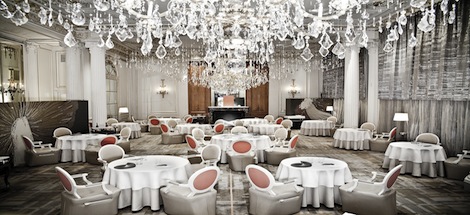TRIPS
posted on 19th Oct 2014
Alain Ducasse’s Au Plaza Athenee

In August, the iconic Plaza Athenee on the fashionable Avenue Montaigne reopened after a refurbishment. It houses Alain Ducasse’s Au Plaza Athenee.
In thirty years, Alain Ducasse, the famous chef, has developed his own unique expertise in lifestyle and gourmet cuisine. He is both a chef-designer, producing meals that are just right, and a businessman, working to establish a modern business model, pass on his knowledge and maintain an open mind when it comes to the world of cooking and hospitality.
Alain Ducasse is the head of more than twenty restaurants worldwide (including three with three Michelin stars that bear his name), three delightful inns and a chain of traditional, independent hotels. His view of his profession is based on two main ideas - his desire to share his passion for good food and his determination to pass on his knowledge.
This can be seen in his books, his courses for professional chefs and enthusiastic amateurs and his consultancy work. He has an enquiring mind that steeps itself in the rich diversity and culture of the world as a whole.
Alain Ducasse Au Plaza Athenee
“Nourishing oneself in a healthier and more natural way is an expectation and a necessity that it is now time to implement in haute cuisine. Exceptional produce expressing their qualities in simplicity, a technique whose elegance is to fade into the shadows to better serve them. This is cooking as I love it most. A cuisine of naturalness, unfettered, liberated. This very personal interpretation is now an integral part of my restaurant at the Plaza Athenee.”
Alain Ducasse has developed his cuisine at the Plaza Athenee around a trilogy of fish, vegetables and cereal, which constitute the bulk of his menu. The Chef says “There is an absolute necessity to go towards a better way of eating, in harmony with nature, healthier and more environmentally friendly.”
Humble Produce at the service of gastronomy?
“I am convinced that the time has come to give an interpretation of haute cuisine to these modest products. In my opinion, this is not a constraint. It is a world of new flavors that I am offering my clients to explore.”
Stringent quality requirements are applied to both fishing and to vegetables and cereals grown by “Small producers living in the heart of their land”.
“Sourcing follows nature’s rhythm, to which the cook aligns and adapts himself.”
The gardeners themselves visit the kitchen to check if the original flavors of their product have been retained. This exchange will help fine tune the osmosis between the gardener and the chef.
Cereal comes from the Latin “Ceres” at the “heart of nutrition in every civilization.” “The use of cereals or pseudo cereals is a sophisticated art. Buckwheat is served as “Kasha” shelled and roasted. Quinoa is cooked in a “Tajine “making it simultaneously soft and firm under the tooth. Red Corn finds favor thanks to a farmer from Basque who discovered its fortitude and low irrigation needs. The Taxil family, passionate farmers from the Hautes-Alps, supplies chickpeas which have been individually sorted by hand.
Overall the cuisine has a soul. Alain Ducasse feels a love towards Japanese cooking. He invited Toshio Tanahashi to share his experience of Shojin cooking. Originating in China, Shojin cooking flourished in Japanese Buddhist temples in the 7th century. In the Gesshinji temple (Shoji province), a nun who had dedicated her life to perfecting the art took 3 years to initiate Toshio Tanahashi. Her profound approach taught him to “listen to the vegetables tell you how they would like to be prepared.”
The Wine Menu is a reflection of the naturalness cuisine. For the ‘Table Cabane,’ which is located in a monumental structure in the shape of a hull, the guest can, if he so desires, order wine the moment the table is booked. The bottle will then be “Mise a la epaule” meaning brought up from the cellar and served at the most optimal time. The ceremony consists of the wine being poured into a decanter. The bottle is then rinsed with the wine to get rid of any deposits. Then the wine is returned to its original bottle. The guest can perform this ritual himself in front of his guests.
The restaurant space has been designed so that the guests can enjoy simultaneously an extraordinary and intimate experience. The uniforms are designed by George Feghaly, whose workshops are located in Monaco.
The unique pieces and tableware tell their own story but all tell the story “spun by Alain Ducasse for his restaurant at The Plaza Athenee.”

Back to top
